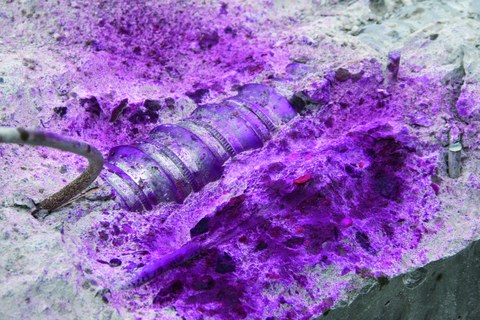SpRK-Risiko von Hennigsdorfer Spannstahl für den Produktionszeitraum bis 1993
Inhaltsverzeichnis
Projektdaten
|
Titel | Title |
Bericht aus dem Jahrbuch 2010
Ältere Spannstähle im Test

Bestimmung der Karbonatisierungstiefe an einer Großprobe
Seit vor über 70 Jahren die erste Spannbetonbrücke Deutschlands in Aue errichtet worden ist, hat sich der Spannbeton zu einer robusten und sehr leistungsfähigen Bauweise entwickelt. Es gab aber auch immer wieder Schadensfälle durch Spannungsrisskorrosion (SpRK). Die Hauptschadensgründe waren (1) die Verwendung von Spannstahl, der für diese spezielle Art der Korrosion besonders empfindlich war und (2) Defizite bei der Bauausführung, da oft Feuchtigkeit ungehindert zu den Spannstählen gelangen konnte.
Spannungsrisskorrosion läuft in drei Phasen ab: vorausgehende Korrosionsvorgänge und Anrissbildung, Rissausbreitung und Versagen. Der Prozess kann wenige Tage, aber auch viele Jahre dauern. Es entstehen i. d. R. kaum Korrosionsprodukte. Besonders kritisch ist, dass Spannstahl mit SpRK plötzlich und extrem spröde versagen kann. Für Spannbetonbauwerke bedeutet dies, dass sich ein drohendes Versagen nicht durch vorherige Rissbildung ankündigen würde.
Bei zwei älteren vergüteten Stahlsorten ist die Anfälligkeit gegenüber dieser Art der Korrosion seit langem bekannt. Dieser Stahl wird schon seit vielen Jahren nicht mehr hergestellt. Ob der in der ehemaligen DDR hergestellte Spannstahl aus dem Stahlwerk Hennigsdorf ebenfalls gefährdet ist, ist Thema der laufenden Untersuchungen. In diesem Projekt werden Materialtests an Spannstählen verschiedener Hersteller, vorwiegend jedoch aus Hennigsdorfer Produktion, aus verschiedenen Herstellungsjahren durchgeführt, um Erkenntnisse über den gesamten Herstellungszeitraum bis Anfang der 1990er Jahre zu gewinnen. Die Proben werden zumeist bei Brückenabbrüchen von verschiedensten Brückentypen gewonnen. Zunächst werden Großproben aus dem Bauwerk heraus getrennt. An denen werden zuerst die Kennwerte des Betons ermittelt (z. B. Festigkeit oder Karbonatisierung). Es folgen das Freilegen der Hüllrohre und deren visuelle Beurteilung sowie die visuelle und chemische Untersuchung des Verpressmörtels. Abschließend werden einzelne Spannstäbe extrahiert. Diese werden im Hinblick auf vorhandene Anrisse untersucht, bevor die Zugfestigkeit und die Spannungs-Dehnungs-Linien ermittelt werden. Sogenannte FIP-Tests an der MFPA Leipzig – das sind Dauerstandsversuche in einem äußerst aggressiven Medium – sollen ebenfalls Kennwerte über die Empfindlichkeit der Spannstähle liefern.
